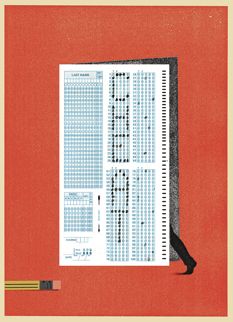Rachel Aviv at the New Yorker on a middle-school cheating scandal that defines the era of No Child Left Behind:
 One afternoon in the spring of 2006, Damany Lewis, a math teacher at Parks Middle School, in Atlanta, unlocked the room where standardized tests were kept. It was the week before his students took the Criterion-Referenced Competency Test, which determined whether schools in Georgia had met federal standards of achievement. The tests were wrapped in cellophane and stacked in cardboard boxes. Lewis, a slim twenty-nine-year-old with dreadlocks, contemplated opening the test with scissors, but he thought his cut marks would be too obvious. Instead, he left the school, walked to the corner store, and bought a razor blade. When he returned, he slit open the cellophane and gently pulled a test book from its wrapping. Then he used a lighter to warm the razor, which he wedged under the adhesive sealing the booklet, and peeled back the tab.
One afternoon in the spring of 2006, Damany Lewis, a math teacher at Parks Middle School, in Atlanta, unlocked the room where standardized tests were kept. It was the week before his students took the Criterion-Referenced Competency Test, which determined whether schools in Georgia had met federal standards of achievement. The tests were wrapped in cellophane and stacked in cardboard boxes. Lewis, a slim twenty-nine-year-old with dreadlocks, contemplated opening the test with scissors, but he thought his cut marks would be too obvious. Instead, he left the school, walked to the corner store, and bought a razor blade. When he returned, he slit open the cellophane and gently pulled a test book from its wrapping. Then he used a lighter to warm the razor, which he wedged under the adhesive sealing the booklet, and peeled back the tab.
He photocopied the math, reading, and language-arts sections—the subjects that would determine, under the No Child Left Behind guidelines, whether Parks would be classified as a “school in need of improvement” for the sixth year in a row. Unless fifty-eight per cent of students passed the math portion of the test and sixty-seven per cent passed in language arts, the state could shut down the school. Lewis put on gloves, to prevent oil from his hands from leaving a residue on the plastic, and then used his lighter to melt the edges of the cellophane together, so that it appeared as if the package had never been opened. He gave the reading and language-arts sections to two teachers he trusted and took the math section home…
Parks Middle School is three miles south of downtown Atlanta, in Pittsburgh, a neighborhood bordered by a run-down trucking lot and railway tracks fallen into disuse. Founded after the Civil War, Pittsburgh was a black working-class area until the nineteen-sixties and seventies, when residents began leaving for the suburbs. Half the homes in the neighborhood are now vacant. Lewis’s students called the area Little Vietnam and Jack City, because of all the armed robberies. Once, when Lewis stopped at a convenience store to tell his students to go home and do their homework, a prostitute approached him. “I’m, like, ‘Whoa, whoa, I’m a teacher!’ ” he said. “And she’s, like, ‘I don’t care. Teachers get down.’ ”…
His students, who came to school with bad breath and parkas that smelled of urine, seemed to lack the conviction that they would ever leave the neighborhood. Parks was run by an older woman who was not inclined to innovate. Homework was a joke. There was litter in the hallways, and students urinated in trash cans. A veteran teacher told Lewis that only twenty per cent of his students would grasp what he was teaching, so he should go over each lesson five times. “Please—I’m a better teacher than that,” he remembered thinking. “She was just making excuses for why she spiralled in circles.”
Read the rest here.
David L. Ulin at the LA Times:
